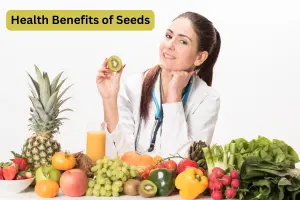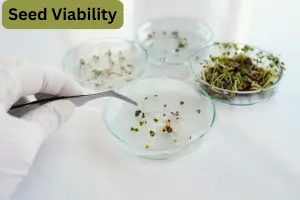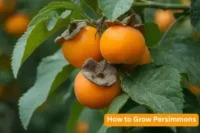Monocots vs. Dicots: Key Differences Every Gardener Must Know
Published: 10 Dec 2025
Hello Green Thumbs!
Do you know the difference between monocots and dicots? Think of monocots and dicots as two different types of blueprints for building a house. While both will eventually give you a fully functional home, the layout and structure differ, just like how monocots and dicots grow. These differences, like the number of cotyledons, influence how plants develop. Learning about these cotyledons will help you better identify and care for plants in your garden or studies.
Sheila, an expert with seven years of experience in botany research, brings her knowledge to this article. This article will explore key differences between monocots and dicots, from seed anatomy to practical gardening tips.
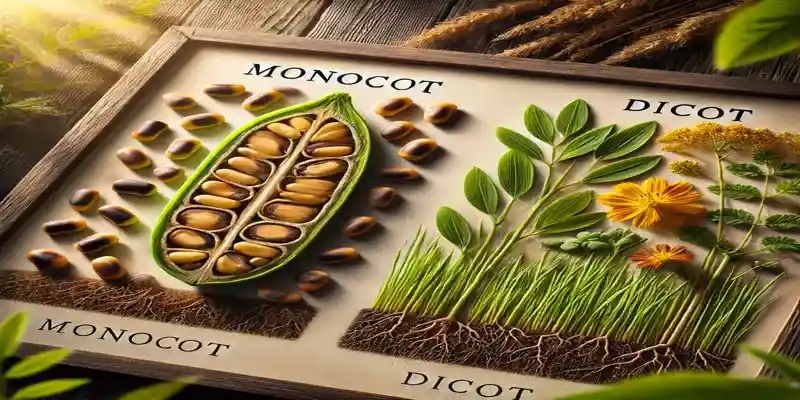
After reading this article, you’ll understand monocots and dicots, their growth patterns, and why they matter. Ready to dive in?
Let’s explore the world of plants!
Key Differences Between Monocots and Dicots
When you examine monocots and dicots, you’ll notice several notable distinctions, similar to identifying unique design styles. Each characteristic, such as leaf growth patterns or root development, shapes the plant’s overall structure and growth.
Let’s explore these differences to make identifying these plants simpler.
| Features | Monocots | Dicots |
|---|---|---|
| Cotyledons | Monocots have a single cotyledon (seed leaf). | Dicots have two cotyledons. |
| Leaf Venation | Leaves have parallel veins, like lines on a road. | Leaves show reticulate (branched) veins, like a web. |
| Vascular Bundle Arrangements | Vascular bundles are scattered throughout the stem, resembling dots on a canvas. | Vascular bundles are arranged in a neat ring, like a bracelet. |
| Root Developments | Flowers typically have parts in multiples of three (e.g, 3 petals). | Dicots grow a taproot system, anchoring deeply like a sturdy pole. |
| Flower Parts | Flowers usually have parts in multiples of four or five (e.g, 5 petals). | Flowers usually have parts in multiples of four or five (e.g 5 petals). |
What Are Monocots and Dicots?
- Monocots and dicots are two main types of seed plants. They have distinct characteristics that influence their growth and development.
- Recognizing these differences helps gardeners, students, and plant enthusiasts identify and care for them more effectively.
Let’s explore their key features.
Definition of Monocots
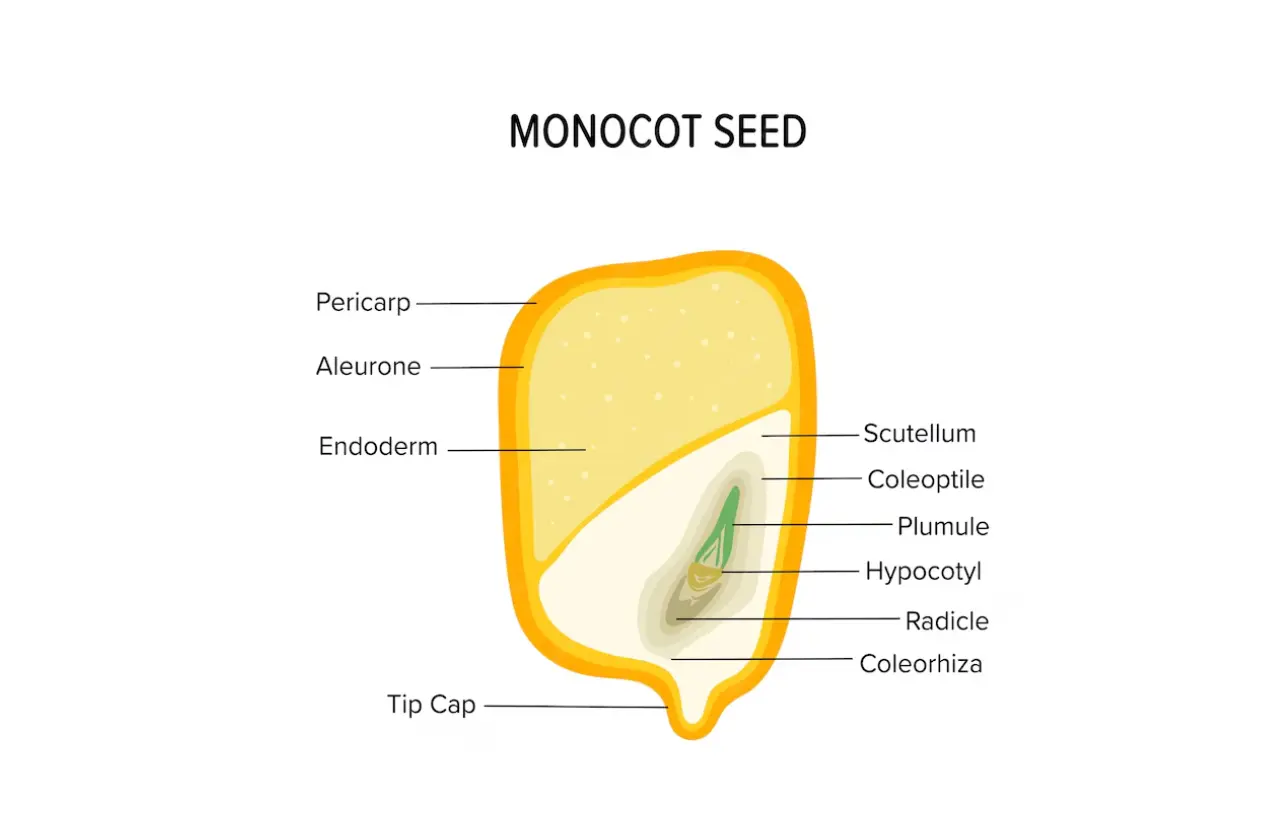
- Monocots produce seeds with only one cotyledon or seed leaf. It’s like having a single foundation stone in the design of a house, on which everything else is built.
- Examples: Monocots include plants like lilies, tulips, and grasses.
- They often exhibit parallel-veined leaves and fibrous root systems.
Definition of Dicots
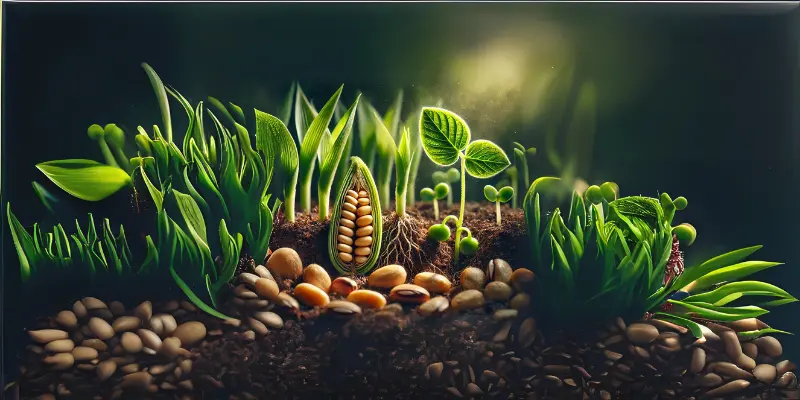
- Dicots are plants with seeds that contain two cotyledons. This arrangement resembles building a house with two primary foundation stones, offering more stability and structure as the plant grows.
- Examples: Common dicots include roses, pumpkins, beans, and sunflowers.
- These plants typically have branched veins in their leaves and a taproot system that grows deeper into the soil.
Seed Anatomy of Monocots and Dicots
Seeds mark the beginning of a plant’s life, laying the foundation for its growth and development. By exploring the anatomy of monocot and dicot seeds, we can better understand what sets them apart and how they grow.
Let’s explore what makes each one unique.
Anatomy of a Monocot Seed
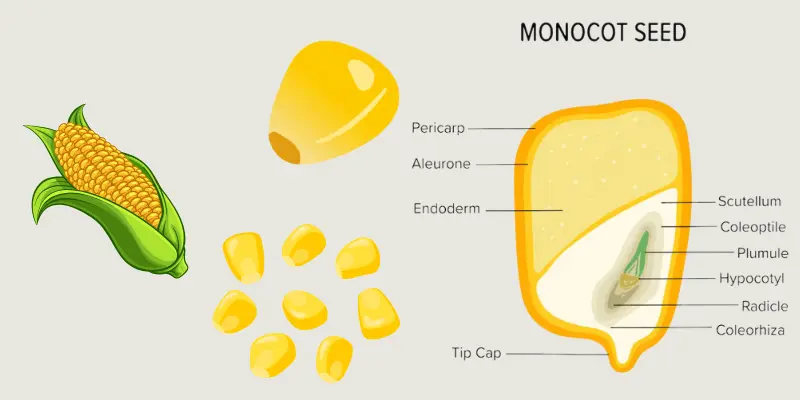
- Cotyledon: Monocots have a single cotyledon that acts like a compact food storage unit, supplying energy to the seedling during its early growth stages.
- Endosperm: The endosperm in monocot seeds remains prominent. It serves as a reservoir of starch and nutrients, like a pantry stocked with essentials for survival.
- Seed Coat: The seed coat is the tough outer layer that protects the seed from harsh environmental conditions, similar to a shield guarding a precious gem.
- Embryo: The embryo is the heart of the seed, housing the future plant. It includes vital structures like the shoot and root primordium, which will grow into the plant’s stems and roots.
Anatomy of a Dicot Seed
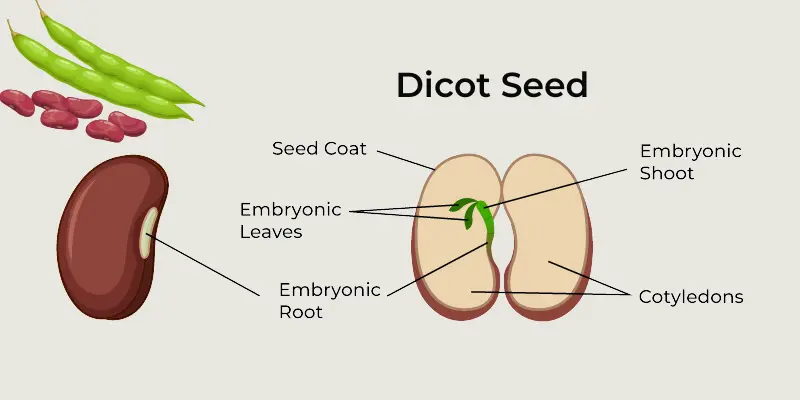
Dicot seeds are like a double-packed suitcase, offering more resources to help the seedling on its journey. These seeds are uniquely designed to provide protection and nourishment, setting the stage for robust growth.
Let’s break down their key features:
- Cotyledons: Dicot seeds have two cotyledons that are often thicker than those in monocots. These act as nutrient-rich storage units, much like two well-stocked backpacks, providing the seedling with everything it needs to start growing.
- Endosperm: Unlike monocots, dicots absorb most of the endosperm into the cotyledons before the seed matures. It is like having the nutrients packed neatly into the backpacks, ready for use as soon as the seed germinates.
- Seed Coat: Dicot seeds also have a protective seed coat. This coat is even thicker in some species, offering extra defence against environmental challenges, like reinforced armour that shields the treasure inside.
- Embryo: The embryo in dicot seeds is similar to that of monocots but is primed to grow into a more complex vascular system. It’s like a detailed blueprint for developing sturdy roots and stems to support the plant as it matures.
Examples of Monocots and Dicots
Let’s look closely at some common examples of monocots and dicots.
Examples of Monocots
Here are some examples of monocots with their features:
| Plants | Explanation |
| Lillies | Lilies are monocots because they have a single cotyledon, parallel-veined leaves, and flower parts in multiples of three. Their shiny, uniform leaf structure is a feature of this category. |
| Tulips | Like tulips and lilies, Daffodils showcase monocot traits, including a single-seeded leaf, parallel venation, and simple fibrous roots. Their elegant floral symmetry further aligns them with monocots. |
| Daffodils | Like tulips and lilies, Daffodils showcase monocot traits with a single seed leaf, parallel venation, and simple fibrous roots. Their elegant floral symmetry further aligns them with monocots. |
| Grasses | Grasses are the ideal monocots with narrow, parallel-veined leaves and fibrous root systems that form dense mats. They’re vital for ecosystems and agriculture. |
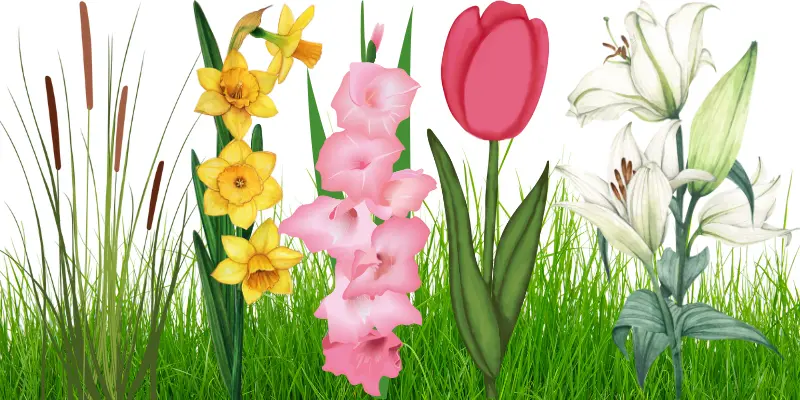
Examples of Dicots
Some examples of dicots with features are given below:
| Plants | Explanation |
| Roses | Roses are classic dicots, with two cotyledons, reticulate leaf venation, and flowers with parts in multiples of five. Their broad leaves and strong root systems also distinguish them. |
| Beans | Beans are an excellent example of dicots, with their two cotyledons packed with nutrients, taproot systems, and branched veins in their leaves. Their germination process is a textbook case of dicot growth. |
| Sunflower | Sunflowers are easily identified as dicots by their broad leaves, network-like veins, and floral arrangements based on multiples of five. They’re also iconic for their role in pollination. |
| Apple | Apple trees exhibit all the hallmarks of dicots, from their deep taproots to the intricate vein patterns in their leaves and complex branching structures. |

Why Do Monocots and Dicots Matter in Gardening?
Gardening is more than just planting seeds: it’s about understanding the plants you’re working with. Knowing whether a plant is a monocot or a dicot is like having a customized care guide. It helps you make smarter decisions about planting, watering, and providing the proper nutrients. Let’s dive into why this knowledge is so valuable for gardeners.
Practical Importance for Gardeners
- Knowing the difference between monocots and dicots can save gardeners time and effort. For example, monocots, such as grasses, thrive with shallow, frequent watering due to their fibrous roots, while dicots, like roses, require deeper, less frequent watering because of their taproots.
- Recognizing whether a plant absorbs water gradually or in large amounts helps you learn its unique needs. This insight also helps choose the right plants for specific soil types and light conditions, making gardening more efficient and enjoyable.
| Interesting Facts |
|---|
|
Why Seed Classification is Important for Plant Care
- The plant’s seed type affects how it grows and what it needs to stay healthy.
- Monocots, with their scattered veins and parallel leaf patterns, usually need less care but may require more water.
- Conversely, dicots with more complex vein systems may need richer soil to support their branching growth. Meeting these needs helps the plant grow strong and healthy.
Conclusion
The differences between monocots and dicots lie in their seed structure: monocots have one seed leaf (cotyledon), while dicots have two. This structure affects their leaf venation, root systems, and growth patterns.
Knowing these differences helps you understand plant biology and make better gardening choices. Explore more examples to deepen your knowledge and see their importance in horticulture.
Start learning today and grow your gardening skills!
FAQs About the Differences Between Monocots and Dicots
You can learn more about the differences between monocots and dicots in the frequently asked questions:
Monocots are seeds with one cotyledon, while dicots have two cotyledons. This fundamental difference influences their growth patterns, leaf structure, and vascular systems.
Monocots typically have parallel-veined leaves, fibrous root systems, and flower parts in multiples of three. Common examples include lilies and grasses.
Roses are dicots. They have two cotyledons, branching veins in their leaves, and flower parts in multiples of five.
Monocots generally require less intense care and shallow, frequent watering, while dicots need deeper watering and more nutrients due to their taproots and complex vascular systems. Understanding these needs helps ensure better plant health.
Monocots, like grasses, typically require more frequent watering due to their fibrous root systems. Dicots, such as roses, need deeper, less frequent watering because they have taproots.
Tulips are monocots. They have a single cotyledon, and their leaves display parallel venation, characteristic of monocot plants.
| References |
|---|

- Be Respectful
- Stay Relevant
- Stay Positive
- True Feedback
- Encourage Discussion
- Avoid Spamming
- No Fake News
- Don't Copy-Paste
- No Personal Attacks

- Be Respectful
- Stay Relevant
- Stay Positive
- True Feedback
- Encourage Discussion
- Avoid Spamming
- No Fake News
- Don't Copy-Paste
- No Personal Attacks
